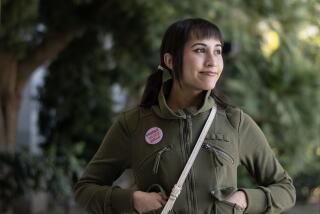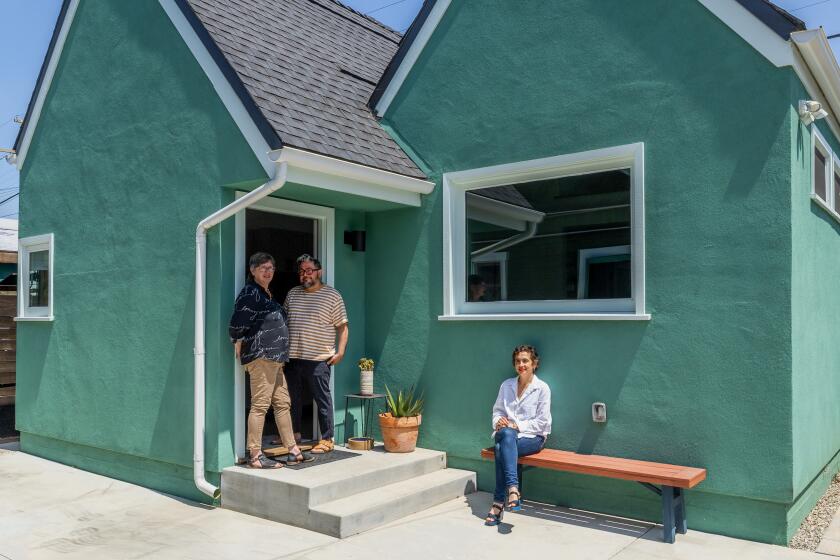Caretakers of the Birthplace of Los Angeles : A new commission tries to revitalize Olvera Street and adjoining historic Pueblo.
Lydia Lopez, 53, is president of the city commission formed last year to oversee and improve Olvera Street and the adjacent birthplace of the city, El Pueblo de Los Angeles. The panel took control of the two-block Downtown area at a time of declining visitor numbers and charges of deteriorating conditions. Lopez’s position is unpaid. She and a majority of the commission, called El Pueblo de Los Angeles Historical Monument Authority, have waived their $50-a-meeting stipend. She was interviewed by Mike Wyma.
*
The commission came into being last August, so we’ve been working for nine months. One of the important things we’ve done is interact with the merchants. I spend a lot of time talking to them and hearing their complaints. There are more than 80 of them, and many have been here a long time. Some have been here since the beginning--the establishment of Olvera Street as the Mexican marketplace in 1930.
They’ve really been battered throughout the years. They’ve worked under poor administration, conflicting jurisdictions. At one time the park was run by the city, the county and the state. It was real difficult to get much done--get a straight answer, change a light bulb.
Another factor is that it took four years for the commission to be established. Before that four years came all the work of negotiating the ordinance it’s based on. So for the longest time no one was really tending things in an ongoing, everyday way. When there were problems or decisions to make, people said, “Leave it for the commission.” We have a lot of deferred maintenance on our buildings. Now we’re trying not to let things linger. We’re spending $11 million just on seismic work.
The spirit of people is improving. When I first told them I was president of the new commission and our job was to oversee the whole thing, they said, “Oh, you poor thing.”
The ordinance that created the commission called for an architect, a historian, an arts and culture person, somebody representing the Italian community, somebody representing the Chinese community. My category was as the community person. I’m the former president of UNO in East Los Angeles, and I’ve been a community activist for 25 years.
The commission’s ethnic mix is good because it reflects the history we’re dealing with. Many people don’t realize how rich the history is and the mix of cultures in the early days. You had the French, the Chinese, the Spanish influence, the Mexicans. There’s a plaque in the Pueblo that has the names of the settlers of this city and descriptions of their ethnicity. You see Spanish, Indian, black, mestizo.
Many people think of this as just Olvera Street, but it’s more than that. We have the Pueblo monument too, the place where the city was founded. People come for its history, to see the old buildings and get a sense of what happened. We have wonderful tours here with docents who have been doing this for years.
We’ve been told by our historians that we have the most significant archeological dig in the city. We’re doing a lot of ADA [Americans With Disabilities Act] work. As workers have dug the shafts for three elevators, they’ve found all these treasures. They bring the archeological team in, collect the stuff, photograph it, catalogue it and we’ll display it eventually. Some of the things are from settlers and some from Indians of various time periods.
One of the elevators will get people up to the Italian Hall, which was a hiring hall built in 1850. It will become a museum. One of them will get us up to what will be a viewing of the Siquieros Mural, which was painted about 1936 and it was seen as very anti-American. It shows an Indian crucified on a double cross with an American eagle above him. It was such a controversial theme that the mural was whitewashed, but it’s been restored. The third elevator will get people up to the second story of an office building.
Recently a group of Latino historians, intellectuals and community people got together to form a Latino history association. They might establish a museum or a series of exhibits. We’ll also have a museum of Chinese American history in the Garnier Building.
It’s a much tidier place now, and we’re working to get rid of the stereotype that it’s dangerous. Since the board took over, we’ve had about seven major family-oriented fiestas, and they’ve all gone on without problems. People are seeing that events here are safe. At Cinco de Mayo we had a major increase in our parking revenue, and 60% of our funds come from that. We’re self-supporting.
Right now we’re working on our 16th of September event. It’s the day of Mexican independence, the biggest holiday. It’s funny when I talk to my family in Mexico and they hear all the fuss we make about Cinco de Mayo, which was just a minor skirmish on the way to the revolution.
Hill & Knowlton, a major PR firm, has offered to work pro bono with us for a year. It’ll be great for them to say they came here and were able to put us on the map again. That work is just entering the planning stages.
There truly is so much to promote. You can buy the most beautiful folk art and gorgeous silver. You can buy all of the regional costumes from Mexico, the authentic stuff. You can come here and dress the entire family. You can buy shoes, belts, purses, attache cases, furniture.
What I hear the most is “Olvera Street. My mother took me there as a child.” They come back and say, “Oh, I didn’t realize you have this.” It’s an old treasure that people have forgotten about.
More to Read
Sign up for Essential California
The most important California stories and recommendations in your inbox every morning.
You may occasionally receive promotional content from the Los Angeles Times.






